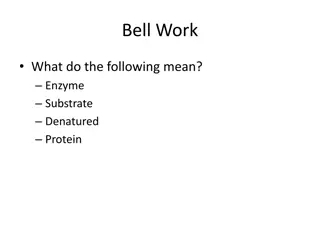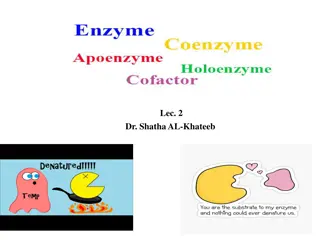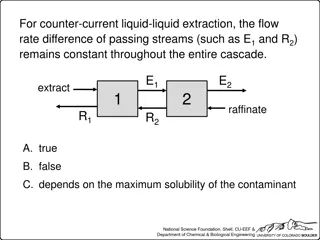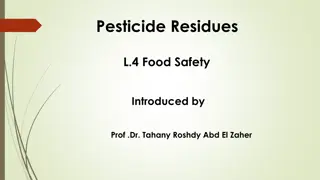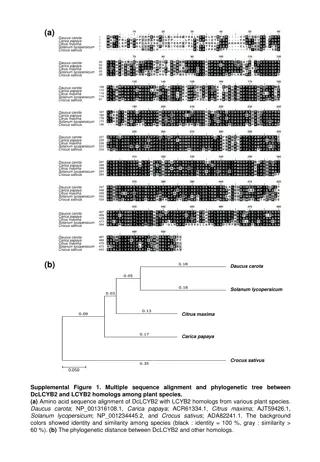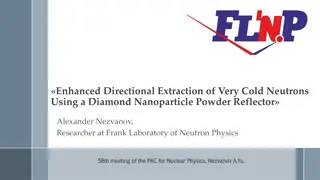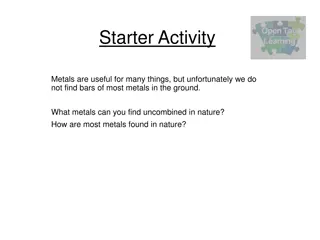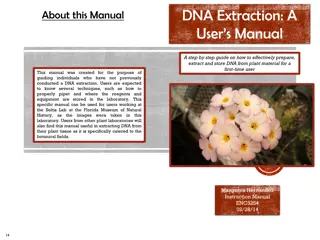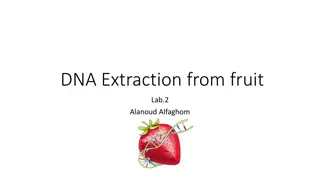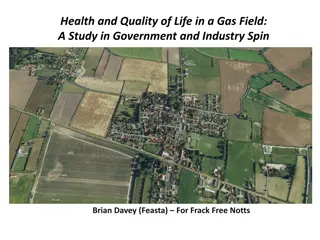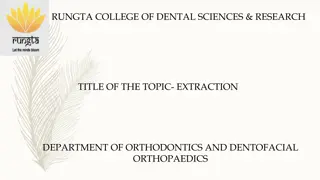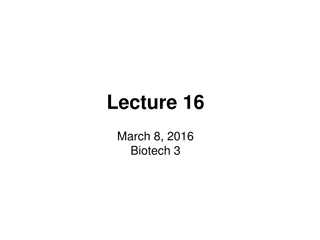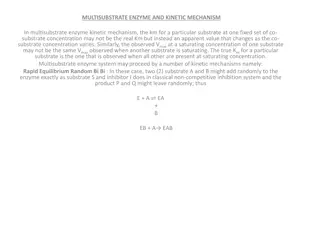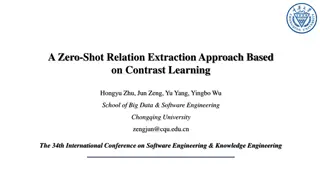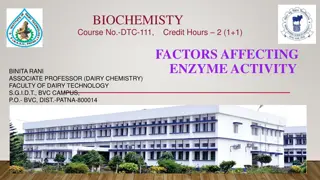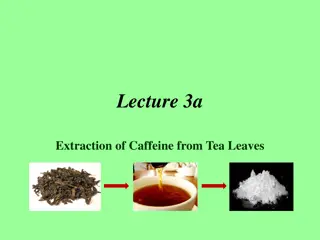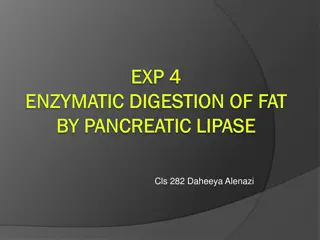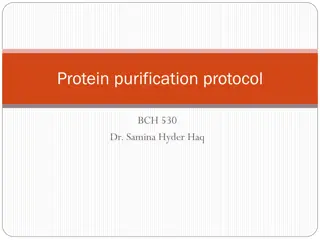Understanding DNA Extraction, Quantitation and Amplification
Learn the fundamentals of DNA extraction, including the two categories of extraction, potential issues, and how to determine the extraction category of your sample.
3 views • 40 slides
Revolutionary Lithium Extraction Technology by SORCIA/IBAT
SORCIA/IBAT's innovative lithium extraction process eliminates the need for chemicals, ensuring efficiency, resource protection, and cost-effectiveness. The modular and mobile plant design allows for rapid deployment with high flexibility, making it a game-changer in the industry. This breakthrough
0 views • 8 slides
Understanding the Role of Phosphatase Enzymes in Metabolic Reactions
Phosphatase enzymes play a crucial role in various metabolic processes by releasing phosphate groups, increasing their availability for energy synthesis and cell structure formation. Acid phosphatases, with an optimum pH below 7.0, can be extracted from plant tissues like germinating mung beans. A p
7 views • 34 slides
Understanding Enzyme Function Through Induced Fit Model
The learning content discusses enzymes as biological catalysts that increase reaction rates by lowering activation energy. It explores how enzyme activity efficiency is influenced by factors such as temperature, pH, and substrate concentration. The Induced Fit Model is analyzed to explain how enzyme
5 views • 12 slides
Understanding DNA Extraction from Strawberries in Molecular Genetics
In this molecular genetics lesson, students explore DNA extraction from strawberries. The content covers the structure of DNA, nucleotides, and the role of DNA in determining genetic information. Students learn about the components of nucleic acids, DNA functions, and the double helix structure of d
0 views • 87 slides
Investigating the Impact of Pineapple Enzyme Bromelain on Gelatin and Pasteurization Process
Explore the effects of pineapple enzyme bromelain on gelatin and how pasteurization can alter its effectiveness in this lab experiment. Discover the different outcomes when using fresh versus canned pineapple and formulate hypotheses to guide the investigation. Follow step-by-step procedures to test
0 views • 15 slides
Factors Affecting Enzyme Activity and Catalysis
Enzyme activity is influenced by various factors such as enzyme concentration, temperature, pH, substrate concentration, inhibitors, activators, and physical agents. The rate of enzyme-catalyzed reactions is directly proportional to enzyme concentration, and temperature plays a significant role with
0 views • 23 slides
Understanding Enzyme Function: The Key Steps and Importance of Cofactors
Enzymes play a crucial role in catalyzing biochemical reactions by forming enzyme-substrate complexes and facilitating changes in substrate molecules to product molecules. The process involves four steps: proximity of enzyme and substrate, binding at the active site, catalysis leading to substrate a
0 views • 39 slides
Liquid-Liquid Extraction Techniques and Considerations
Understanding liquid-liquid extraction processes like counter-current and co-current cascades, material balances, and system degrees of freedom. Topics include impact of flow rates, partition coefficients, solvent ratios, and purity on extraction efficiency.
0 views • 14 slides
Understanding Peroxidase Enzyme Activity in Biological Samples
Demonstrating the enzyme activity of peroxidase, an enzyme that plays a crucial role in breaking down hydrogen peroxide in various organisms. Learn about the differences between peroxidase and catalase, the calculation of enzyme activity, and the significance of extinction coefficient in enzyme assa
0 views • 8 slides
Exploring Enzyme Kinetics for Understanding Chemical Reactions
Enzyme kinetics is a vital discipline focusing on the rate of enzyme-catalyzed reactions and how they respond to varying conditions. Reactions are classified based on reactant concentration influences. Zero, first, second, and third order reactions are distinguished, with examples like first-order r
0 views • 31 slides
Demonstration of Salivary Amylase Enzyme Action in B.Sc. Practical
Salivary amylase, an enzyme found in saliva, partially hydrolyzes starch into maltose. This practical involves observing the action of salivary amylase on starch, demonstrating how starch is broken down into glucose and maltose. The procedure includes preparing solutions, collecting saliva, mixing w
0 views • 5 slides
Enzyme Immobilization: Techniques and Applications in Industry and Healthcare
Enzyme immobilization involves confining enzymes on inert supports for stability and reuse, enhancing efficiency and cost-effectiveness. Historical events and examples illustrate various methods and applications. Chemical modifications, such as PEG addition, have shown increased enzyme activity. The
0 views • 34 slides
Factors Affecting Enzyme Activity and Kinetics Experiments
Explore the factors influencing enzyme activity, such as substrate and enzyme concentration, temperature, pH, and inhibitors. Learn how to simulate enzyme kinetics using equipment like popping beads and stopwatches. Analyze results to understand the impact of substrate concentration on reaction rate
0 views • 22 slides
Extraction Methods in Pesticide Residue Analysis for Food Safety
Extraction methods play a crucial role in separating pesticide residues from food matrices for analysis. Techniques involve using solvents to efficiently remove pesticides without causing chemical changes. The choice of extraction method depends on the substrate type, with liquid and solid substrate
6 views • 25 slides
Understanding Enzyme Activity and Optimal Conditions
This interactive content provides a detailed exploration of enzyme activity through data interpretation and graph analysis. Questions range from identifying the impact of enzymes on specific molecules to determining optimal conditions for various enzyme functions such as pH and temperature. Users de
0 views • 16 slides
Immobilization of Enzymes in Biochemistry
Enzyme immobilization involves confining enzyme molecules to a distinct phase from substrates and products, attaching them to solid matrices for enhanced specificity and reduced inhibition. Inert polymers or inorganic materials are used as carrier matrices with methods like physical adsorption onto
0 views • 24 slides
Understanding Enzyme Inhibition in Biochemistry
Enzyme inhibition plays a crucial role in pharmacology and biochemistry by regulating enzymatic reactions. Inhibitors can be reversible or irreversible, affecting enzyme activity differently. Competitive, uncompetitive, and noncompetitive inhibition types are explained along with examples like diiso
0 views • 20 slides
Slow Extraction Operations at Fermilab Main Injector
Overview of slow extraction operations at Fermilab Main Injector, covering beam transport, low to medium energy user test beams, Drell-Yan experimental beam, and spill procedures. Details on beam targets, production, and observation of high-energy positrons. Also, insights on spill regulation techni
0 views • 12 slides
Plant Enzyme Activities and Phylogenetic Analysis
The content discusses the alignment of various plant enzyme amino acid sequences, including DcLCYB1, DcLCYB2, and DcLCYE, among different inbred lines. It also explores the construction of DcLCYs for enzyme activities using an E. coli complementation assay. The phylogenetic relationship between DcLC
0 views • 5 slides
Enhanced Directional Extraction of Very Cold Neutrons Using Diamond Nanoparticle Reflector
Alexander Nezvanov, a researcher at Frank Laboratory of Neutron Physics, presented a study on enhanced directional extraction of very cold neutrons using a diamond nanoparticle powder reflector. Very cold neutrons (VCN) have unique properties making them ideal for various applications in neutron tec
0 views • 11 slides
Validation Study of Rapeseed Oil Body Extraction Methods
This study explores the validation of two rapeseed oil body extraction methods. It delves into the common uses of rapeseed, the components of oil bodies, and their potential applications in the human food system. The materials and methods section details the extraction processes, including dry and w
2 views • 23 slides
Metal Extraction: Processes and Applications
Metals play a crucial role in various industries, but their extraction from ores is a complex process. Some metals occur naturally in an uncombined form, indicating their low reactivity. Through heat alone, unreactive metals like lead can be separated from their ores. This extraction process involve
2 views • 16 slides
DNA Extraction: A User's Manual for Plant Material
A step-by-step guide on preparing, extracting, and storing DNA from plant material for first-time users, specifically tailored for individuals in botanical fields. The manual covers materials needed, CTAB buffer mixture preparation, leaf material preparation, DNA extraction process, and proper stora
0 views • 8 slides
Demonstration of Salivary Enzyme Amylase Action in B.Sc. Practical
Salivary enzyme amylase, also known as ptyalin, plays a crucial role in breaking down starch and glycogen into maltose. This practical session in the Zoology department explores the action of salivary enzyme amylase at a temperature of 37°C and pH of 6.6. By conducting experiments with starch, iodi
0 views • 8 slides
DNA Extraction from Fruit Lab: Strawberry Extraction Method
Explore the fascinating process of breaking cell barriers and extracting DNA from strawberry cells. This comprehensive lab guide provides detailed instructions on how to extract DNA using simple materials like strawberries, plastic bags, ethanol, liquid detergent, and more. From mashing the fruit to
1 views • 11 slides
Unconventional Gas Extraction: Balancing Industry and Environmental Concerns
Study the implications of unconventional gas extraction on health, quality of life, and the global energy context. Explore the impacts of technologies like shale gas fracking and coal bed methane on climate change, energy supplies, and economic sustainability. Consider the risks posed by water-inten
0 views • 39 slides
Extraction in Orthodontics and Dentofacial Orthopedics: Comprehensive Overview
Painless extraction of teeth is crucial in orthodontic treatment for achieving normal occlusion and creating space in the dental arch. Historical background traces the evolution of extraction in orthodontics. The need for extraction is determined by factors like arch length-tooth material ratio, int
0 views • 38 slides
Automated Information Extraction for Decision Making in Data
Processing unstructured data from sources like news, blogs, and papers is a challenge due to the volume of digital data. The Dutch-Belgian Database Day 2013 discusses event extraction as a solution using natural language processing and statistics. Event extraction can benefit systems in personalized
0 views • 20 slides
Understanding Enzyme Assays in Biotechnology
Exploring enzyme assays in biotechnology, covering topics such as ELISA, protein assays, enzyme activity measurement techniques, specific activity, terminology related to enzyme assays, and different types of experiments conducted by biochemists to study enzyme-catalyzed reactions. The content delve
0 views • 53 slides
Cyanide's Impact on Respiration Through Enzyme Inhibition
Cyanide, a noncompetitive inhibitor of the enzyme cytochrome c oxidase, disrupts electron transport in respiration by binding to the iron cofactor and blocking electron transfer to oxygen. This lethal effect was utilized in gas chambers during WWII, underscoring the crucial role of enzyme function i
0 views • 7 slides
Understanding Multisubstrate Enzyme Kinetic Mechanisms
In multisubstrate enzyme kinetic mechanisms, the apparent Km and Vmax values change with varying substrate concentrations. Different kinetic mechanisms like rapid equilibrium Bi Bi and ordered Bi Bi reactions can occur. The ping-pong Bi Bi reaction involves oscillation between enzyme forms. Various
0 views • 11 slides
Zero-Shot Relation Extraction Based on Contrast Learning
This paper presents a zero-shot relation extraction approach based on contrast learning, aiming to improve the efficiency of relation extraction tasks. The methodology involves utilizing a knowledge graph to extract relational triplets and leveraging zero-shot learning to automate the process. The s
0 views • 21 slides
Factors Affecting Polyphenol Oxidase Activity in Enzyme Reaction
Polyphenol oxidase (PPO) is a copper-containing enzyme with an optimal pH of 6.7 that catalyzes the oxidation of phenols, leading to color changes like browning in fruits and potatoes. This experiment aims to demonstrate PPO activity, its chemical nature, substrate specificity, and the effects of te
0 views • 18 slides
Understanding Factors Affecting Enzyme Activity in Biochemistry
Enzyme assays measure substrate conversion to product under varying conditions like cofactors, pH, and temperature. Enzyme velocity represents the rate of a catalyzed reaction, typically reported as V0. Enzyme activity is expressed as mol of substrate transformed per minute, with enzyme unit and kat
0 views • 18 slides
Understanding Caffeine Extraction from Tea Leaves
Caffeine, a widely consumed alkaloid, is extracted from tea leaves using organic chemistry techniques. This process involves liquid-liquid extraction to isolate the caffeine from the mixture of substances. The efficiency of extraction relies on the solubility of the target compound in a chosen solve
0 views • 17 slides
Enzymatic Digestion of Fat by Pancreatic Lipase
The experiment focuses on studying the enzymatic digestion of fat by pancreatic lipase. It covers the structure of triglycerides, the role of lipase enzyme in hydrolyzing triglycerides to release fatty acids, and the general hydrolysis process. The aim is to investigate the effects of lipase enzyme
0 views • 9 slides
Understanding LacZ - Galactosidase Enzyme: Structure, Function, and Applications
LacZ - galactosidase enzyme, encoded by the lacZ gene in the lac operon, plays a crucial role in cleaving lactose, transgalactosylation, and regulating gene expression. Its application in labs using X-gal as a substrate allows for easy detection of active enzyme through color changes. This versatile
0 views • 13 slides
Protein Purification Protocol: Practical Training in Biochemistry Techniques
This protein purification protocol course, led by Dr. Samina Hyder Haq, focuses on practical training in various biochemistry techniques. The course covers organizing experimental protocols, protein isolation strategies, sequential enzyme purification, enzyme kinetics, and writing scientific reports
0 views • 25 slides
Understanding Enzyme Regulation and Factors Affecting Enzyme Activity
Organisms carefully control enzyme production and activation as per varying needs and conditions within cells. Enzyme activity is influenced by factors such as pH, temperature, regulatory molecules, cofactors, compartmentalization, covalent modification, and feedback inhibition. Enzymes can be regul
0 views • 20 slides





